Reading about space to children aged 3-5 offers numerous benefits by sparking curiosity and expanding their understanding of the world around them. At this stage, children are developing critical thinking and learning to ask questions about the universe, which books about space can stimulate effectively. Introducing concepts such as planets, stars, and the solar system through engaging stories and vibrant illustrations enhances their vocabulary and provides a basic understanding of scientific principles. Moreover, exploring space through reading nurtures imagination and creativity, as children envision themselves exploring new worlds or becoming astronauts. This can also help in developing a sense of adventure and bravery, as they learn about the vastness of the universe and the possibilities it holds.
“There’s No Place Like Space: All About Our Solar System” by Tish Rabe (Published 1999)

This engaging book takes young readers on a journey through the solar system, guided by the iconic characters from Dr. Seuss’s books, the Cat in the Hat, Thing One, and Thing Two. It covers the sun, moon, stars, and each of the planets, providing fun and memorable rhymes along with key facts about each celestial body.
The book is excellent reading material for children because it combines entertaining, whimsical rhymes with educational content. The familiar and beloved Dr. Seuss-style characters make learning about space accessible and fun, effectively capturing the attention of young readers. The rhyming text helps reinforce memory retention of the facts presented, making complex concepts like planetary characteristics and solar system dynamics easier to understand.
“The Darkest Dark” by Chris Hadfield (Published 2016)
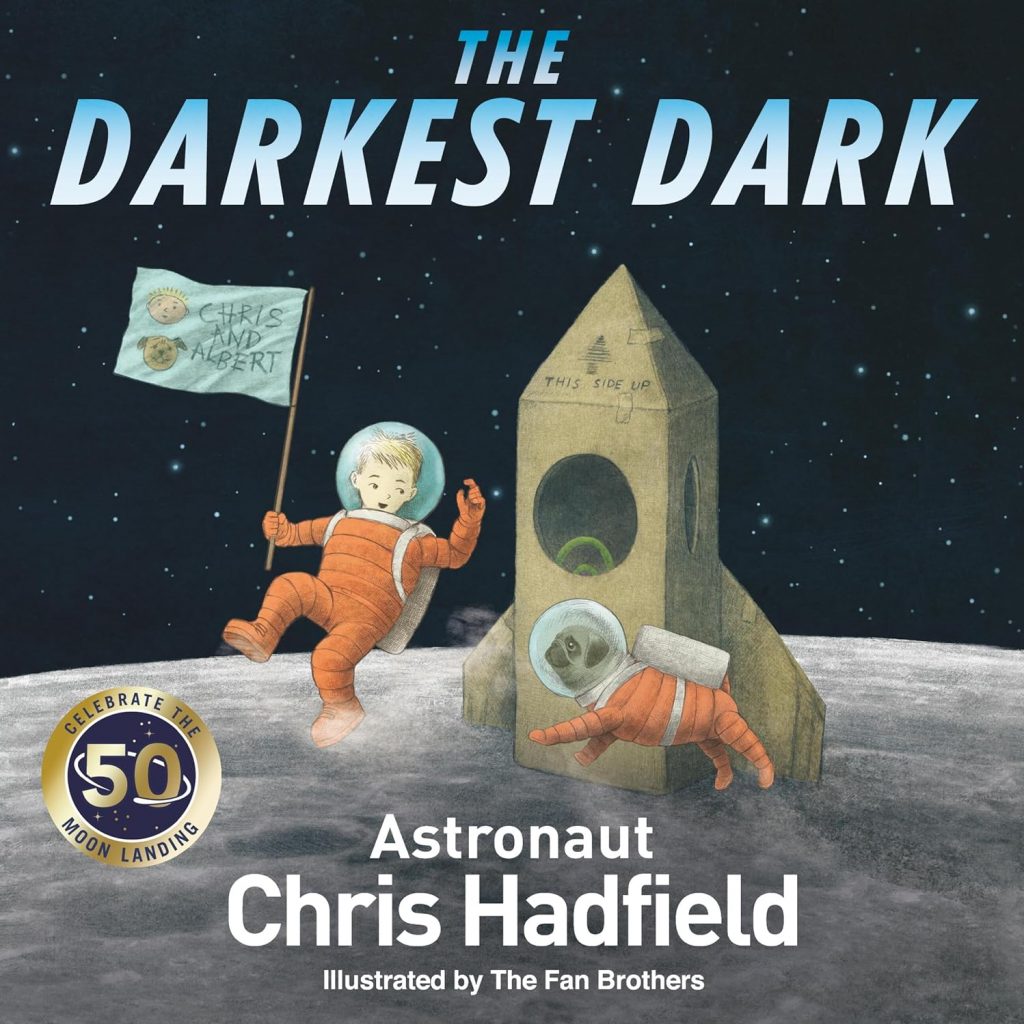
This book is inspired by the childhood of astronaut Chris Hadfield, who dreamt of flying to space ever since he watched the Apollo 11 Moon landing on television as a boy. The story centers around young Chris, who is afraid of the dark—until he realizes that space is the darkest dark there is, and it is beautiful and inviting. This revelation helps him to overcome his fear of the dark back on Earth.
The book excels as reading material for children because it tackles common childhood fears through the inspiring lens of space exploration. It communicates the message that darkness is necessary to see the stars, encouraging children to embrace their fears as opportunities for discovery and adventure. The story is beautifully illustrated, capturing the vastness and wonder of the cosmos as well as the intimacy of a child’s bedroom at night.
“The Darkest Dark” is also educational, as it introduces children to the concept of space travel and the profession of an astronaut through the eyes of one of the most renowned figures in the field. The book includes a message from Chris Hadfield himself, which adds a personal touch and extends an inspiring message about dreams and possibilities.
“Mousetronaut: Based on a (Partially) True Story” by Mark Kelly (Published 2012)
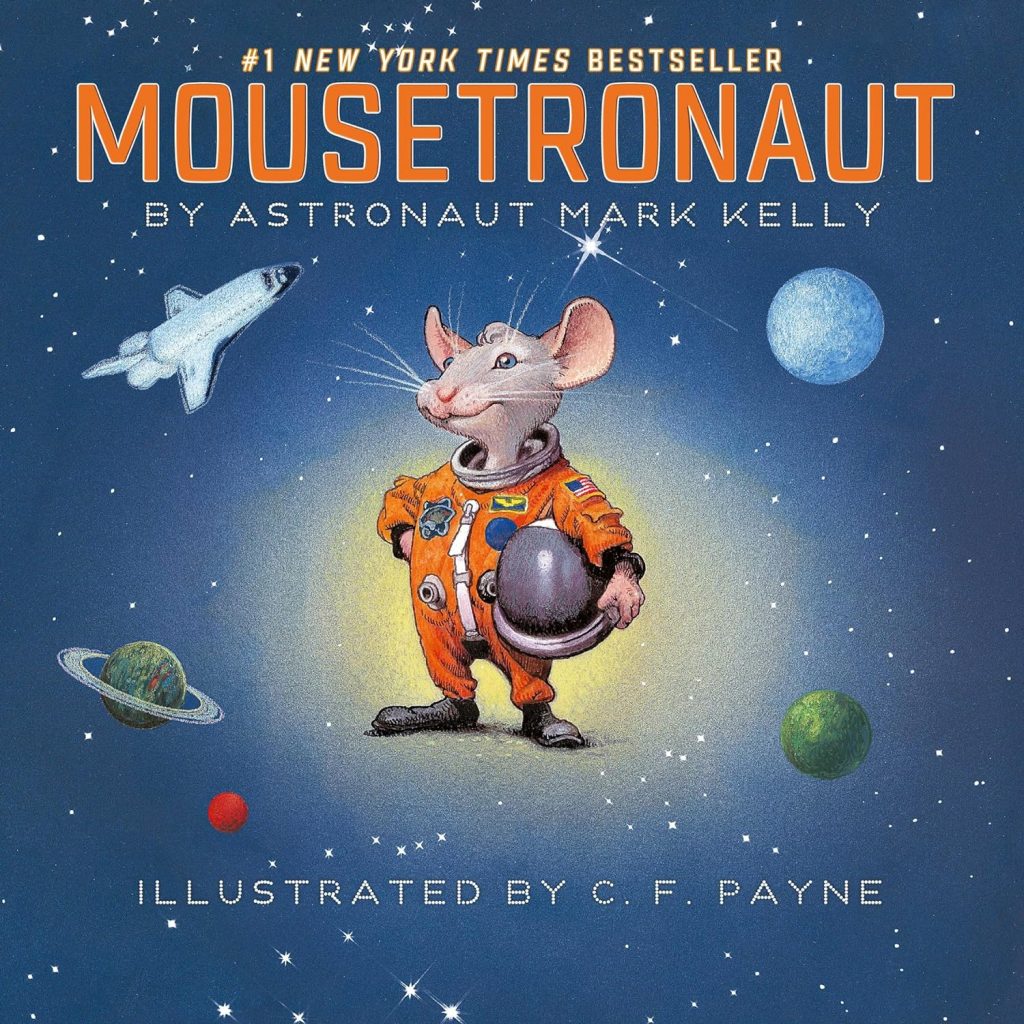
Written by retired astronaut Mark Kelly, this children’s book is inspired by real events from one of his space shuttle missions where a mouse was actually part of the crew. The story centers on a small mouse named Meteor, who is chosen for a space mission. Unlike the other mice, Meteor is not afraid and is very helpful during the flight. His small size turns out to be an advantage when he helps save the mission by fitting into a tight space to fix a problem.
The book is an excellent reading material for young children because it combines an engaging narrative with educational content about space travel. The illustrations are lively and add a fun, adventurous feel to the story. It introduces young readers to the concept of teamwork and how being small doesn’t mean being insignificant—teaching valuable lessons about bravery and usefulness regardless of size.
“Mousetronaut” is particularly notable because it is written by someone who has actually traveled to space, adding authenticity to the details of the space mission described in the story. This book not only entertains but also inspires children by showing them that heroes can come in all sizes, and it sparks curiosity about space and science.
“Roaring Rockets” by Tony Mitton (Published 2000)
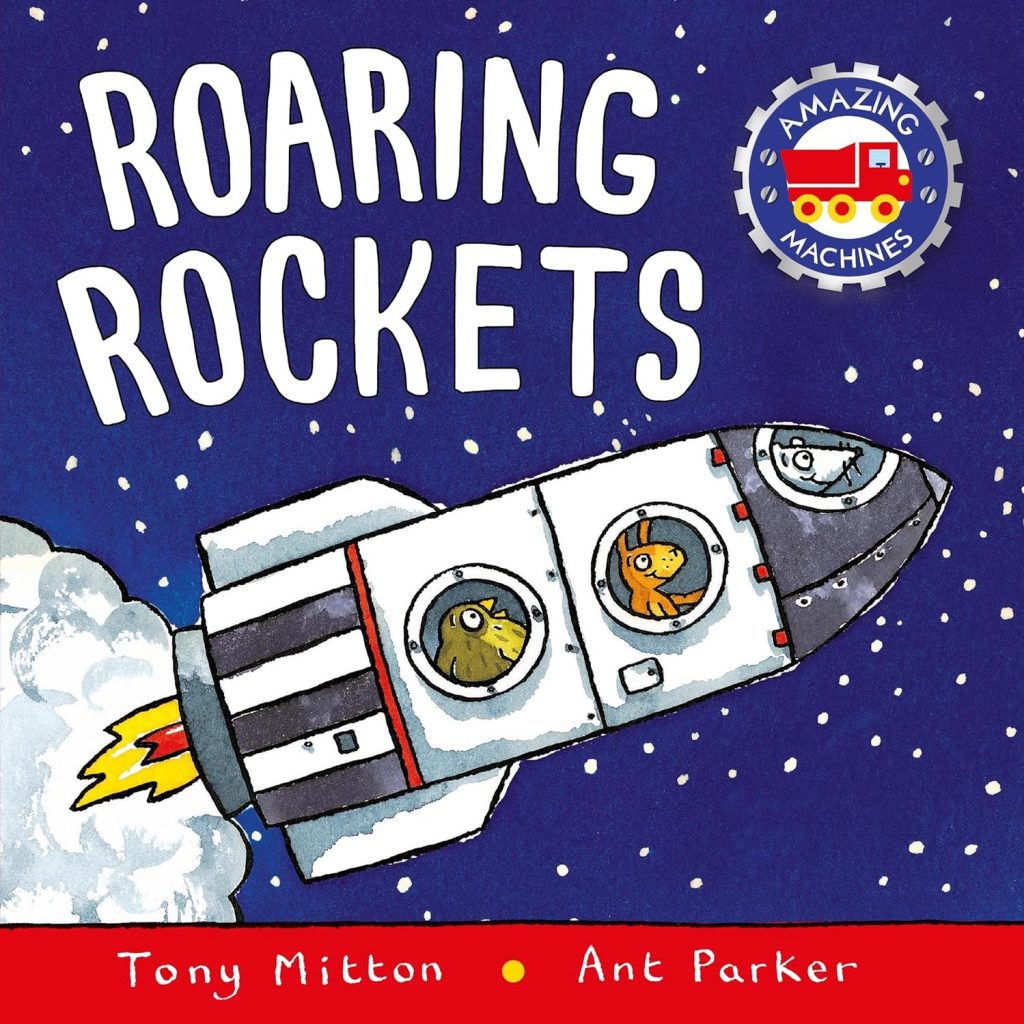
It book is part of the Amazing Machines series, which is known for introducing young children to various types of vehicles and technology through engaging rhymes and bright, colorful illustrations. “Roaring Rockets” follows a group of animal astronauts as they prepare for a journey into space, detailing the parts of a rocket and the process of blasting off into orbit in a way that is fun and easy to understand.
The book is excellent reading material for young children because it combines factual information about rockets and space travel with a playful, rhyming narrative that captures the imagination. The illustrations are lively and filled with fun details, making the experience of reading both educational and entertaining. The text introduces basic space vocabulary in a way that’s accessible to preschoolers, helping to build their understanding of science-related concepts at an early age.
“Roaring Rockets” is particularly good for young readers because it makes the concept of space travel exciting and approachable. The book also includes a spread at the end that provides more detailed information about rockets, appealing to both children’s sense of wonder and their eagerness to learn more about how things work.
“Field Trip to the Moon” by John Hare (Published 2019)
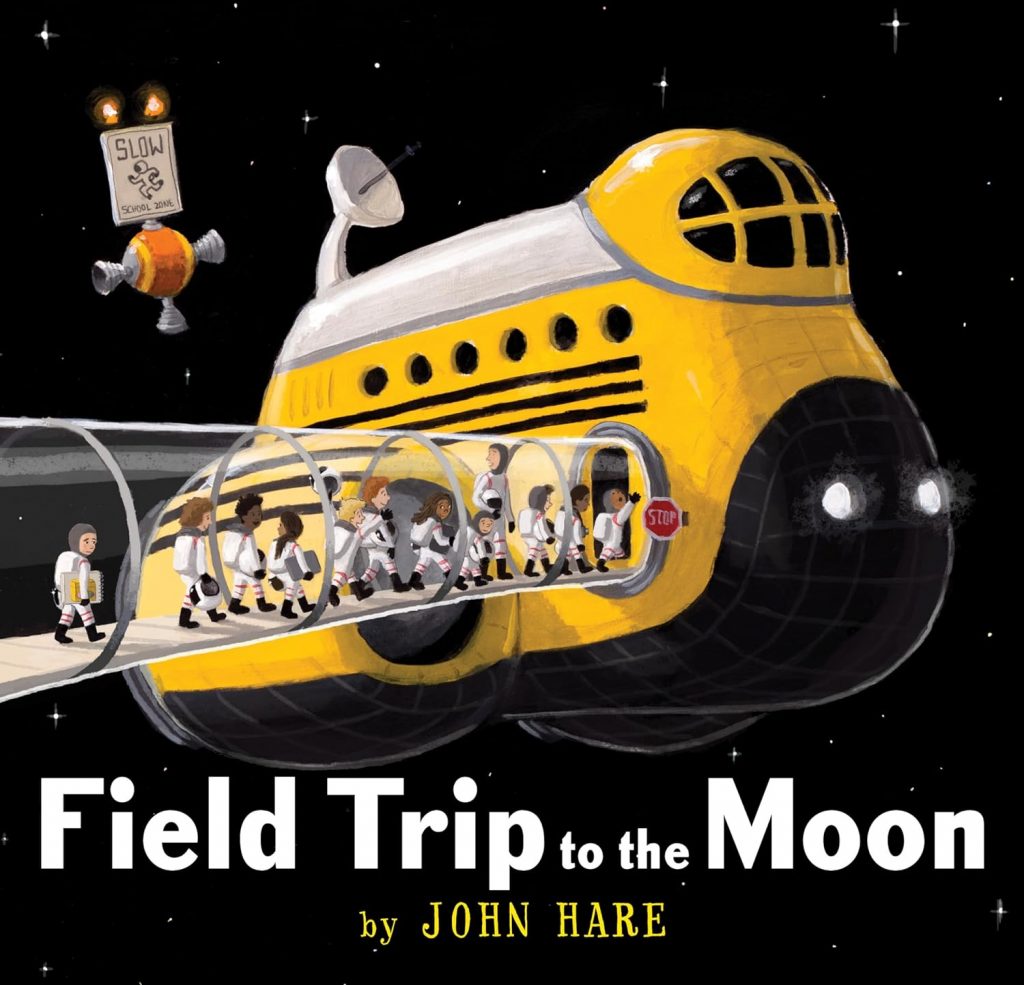
This engaging book offers a unique take on space exploration by imagining a school field trip to the moon. The story is told through detailed and evocative illustrations with very little text, primarily focusing on a visual narrative. It follows a group of students as they explore the moon’s surface, with one child getting separated from the rest and encountering the local moon inhabitants in a series of whimsical and friendly exchanges.
The book is an excellent reading material for young children because it utilizes a creative approach to storytelling that encourages imagination and visual literacy. The artwork is captivating and invites readers to pore over the pages, discovering new details with each read. This wordless or nearly wordless format allows children to create their own interpretations of the events and dialogue, fostering creativity and narrative skills.
“Field Trip to the Moon” is especially noteworthy for its playful and positive portrayal of space, which can help alleviate common fears or misconceptions children might have about such a mysterious and distant place. The inclusion of a diverse group of students in the illustrations also promotes inclusivity and reflects a modern, global approach to education and exploration. Additionally, the book subtly incorporates themes of curiosity, bravery, and discovery, making it a rich resource for lessons or discussions about space, teamwork, and adventure.
“If You Decide To Go To The Moon” by Faith McNulty (Published 2005)
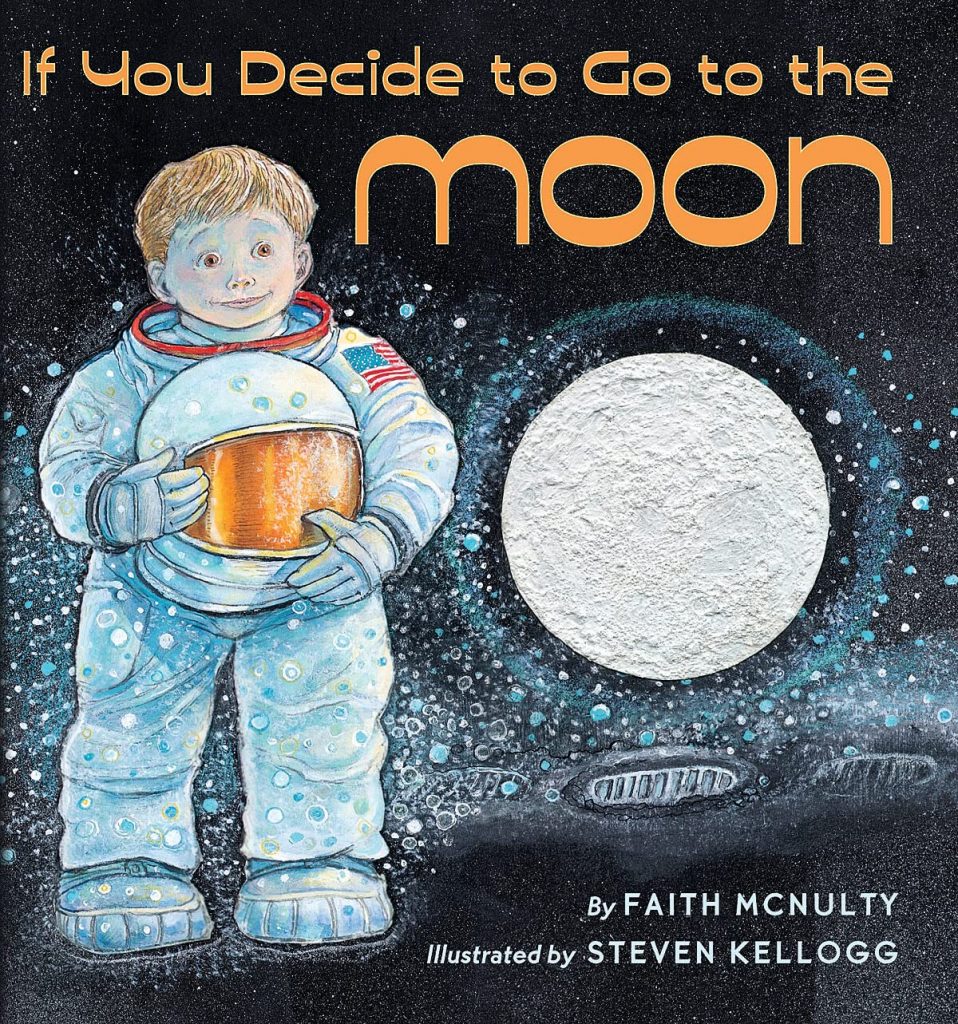
This book takes readers on an imaginative journey to the moon, providing a blend of poetic narrative and practical advice. The book details what a trip to the moon might entail, from the need to wear a spacesuit to protect against the lack of air and extreme temperatures, to the experience of zero gravity, and the sights to be seen on the lunar surface.
The book is excellent reading material for young children because it creatively combines factual information about space and the moon with a narrative that makes the reader feel personally involved in the journey. The illustrations by Steven Kellogg are vibrant and detailed, adding depth and excitement to the story, and effectively complementing the text to capture the vastness and wonder of space travel.
“If You Decide To Go To The Moon” is particularly effective in sparking curiosity about space exploration. It not only informs readers about the physical conditions of the moon and the practicalities of getting there but also captures the loneliness and beauty of space. The book encourages children to think about Earth’s environment and the importance of caring for our planet, providing a broader educational value that goes beyond just learning about space.
“Astronaut Handbook” by Meghan McCarthy (Published 2008)
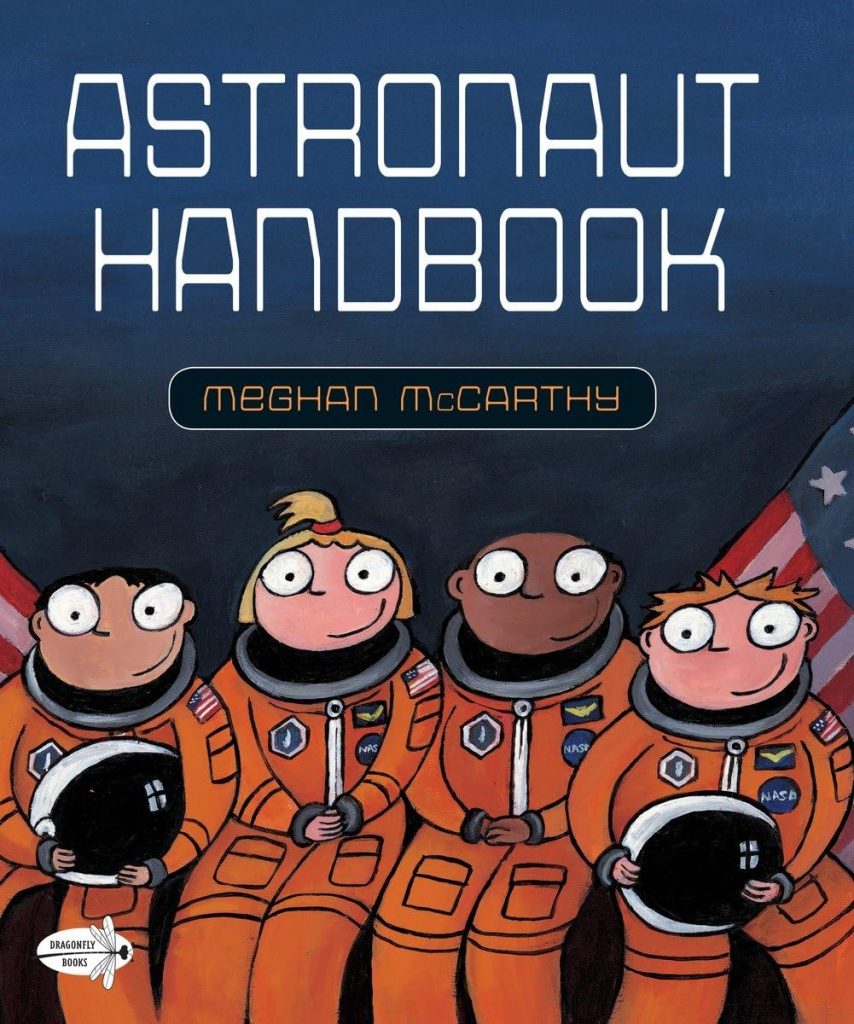
This non-fiction picture book offers a fun and informative look at what it takes to become an astronaut. Through engaging, playful text and Meghan McCarthy’s distinctive, colorful illustrations, the book covers various aspects of astronaut training and life in space, including the rigorous physical and mental preparation required, the teamwork needed, and what daily life is like aboard a space shuttle.
The book is an excellent reading material for children because it presents educational content in an accessible and entertaining way. It demystifies the process of becoming an astronaut, making the information approachable and understandable for young readers. This helps to foster not only an interest in space and science but also inspires perseverance and teamwork.
One notable aspect of “Astronaut Handbook” is its humor and the way it engages readers with fun facts and lesser-known details about life in space, such as sleeping in zero gravity and the types of food astronauts eat. The book also encourages readers to dream big and work hard if they aspire to explore space, making it not just informative but also motivational. It’s an ideal choice for young readers fascinated by space travel and aspiring to learn more about the adventures of astronauts.
“Curious George and the Rocket” by Margret & H.A. Rey (Published 1957)
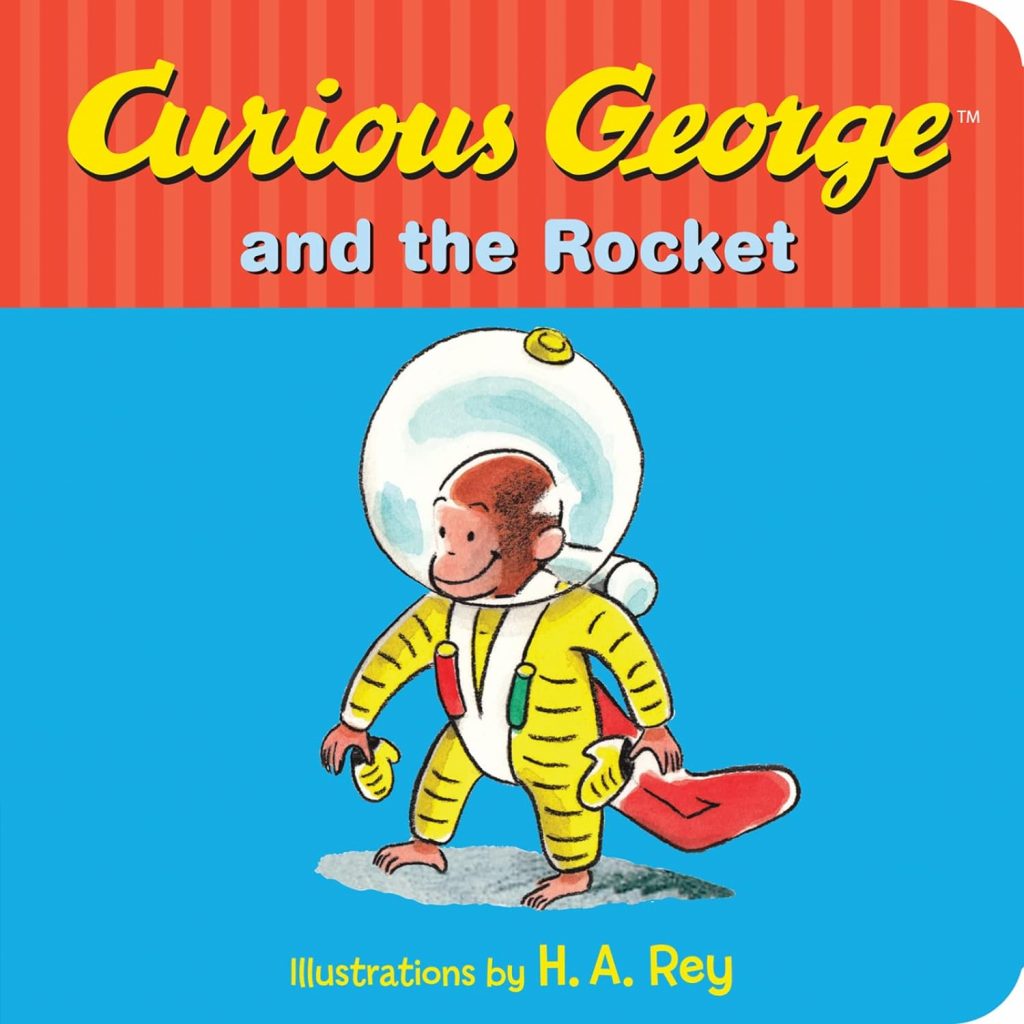
In this classic installment of the Curious George series, the mischievous monkey George finds himself involved in a space mission. After a series of adventures and typical ‘Curious George’ antics around the town, he ends up at a museum where he volunteers for a space mission, ultimately getting to ride in a rocket ship.
The book effectively incorporates the theme of space through George’s unexpected journey to space, making it engaging for young readers. George’s curiosity and playful antics as he explores the rocket and experiences zero gravity make the concept of space travel accessible and fun.
“Curious George and the Rocket” is excellent reading material for children because it combines excitement and humor with educational content. The story not only entertains but also introduces basic concepts of space travel and the idea of exploring new frontiers. George’s character, with his boundless curiosity and ability to turn any situation into an adventure, makes the narrative lively and engaging.
Additionally, the book highlights themes of curiosity, learning, and the consequences of actions in a gentle manner that is suitable for young children. It’s a wonderful way to introduce the concept of space exploration to young readers while entertaining them with George’s delightful misadventures.
“Papa, Please Get the Moon for Me” by Eric Carle (Published 1986)
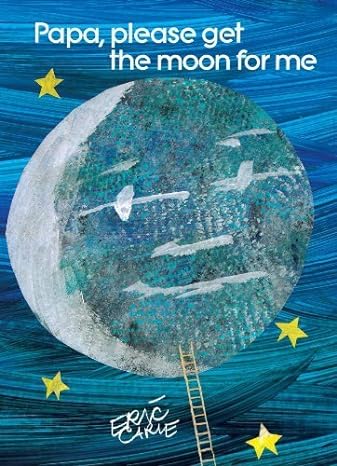
This charming picture book is not about space exploration in the traditional sense but uses the theme of space to weave a story about a girl named Monica who wants to play with the moon. Her father attempts to fulfill her wish by climbing a very tall ladder to reach the moon. The story captures the waxing and waning phases of the moon as it becomes small enough for him to carry home to Monica, only for it to disappear eventually, reflecting the natural cycle of the moon.
The book is excellent reading material for young children because of its imaginative storytelling and the beautiful, expressive illustrations that are a hallmark of Eric Carle’s work. It introduces young readers to concepts such as the phases of the moon in a simple and visually engaging way. The book features Carle’s signature collage art, making it visually captivating and distinct.
Additionally, “Papa, Please Get the Moon for Me” incorporates elements like fold-out pages and varied page sizes that add a physical interactive dimension to the reading experience. These features make the book not just a story to be read but an experience to be interacted with, engaging children’s senses and helping to maintain their interest. The story also conveys themes of love and perseverance, as depicted through the father’s efforts to grant his daughter’s wish, making it a touching read for both children and parents.
“The Way Back Home” by Oliver Jeffers (Published 2007)
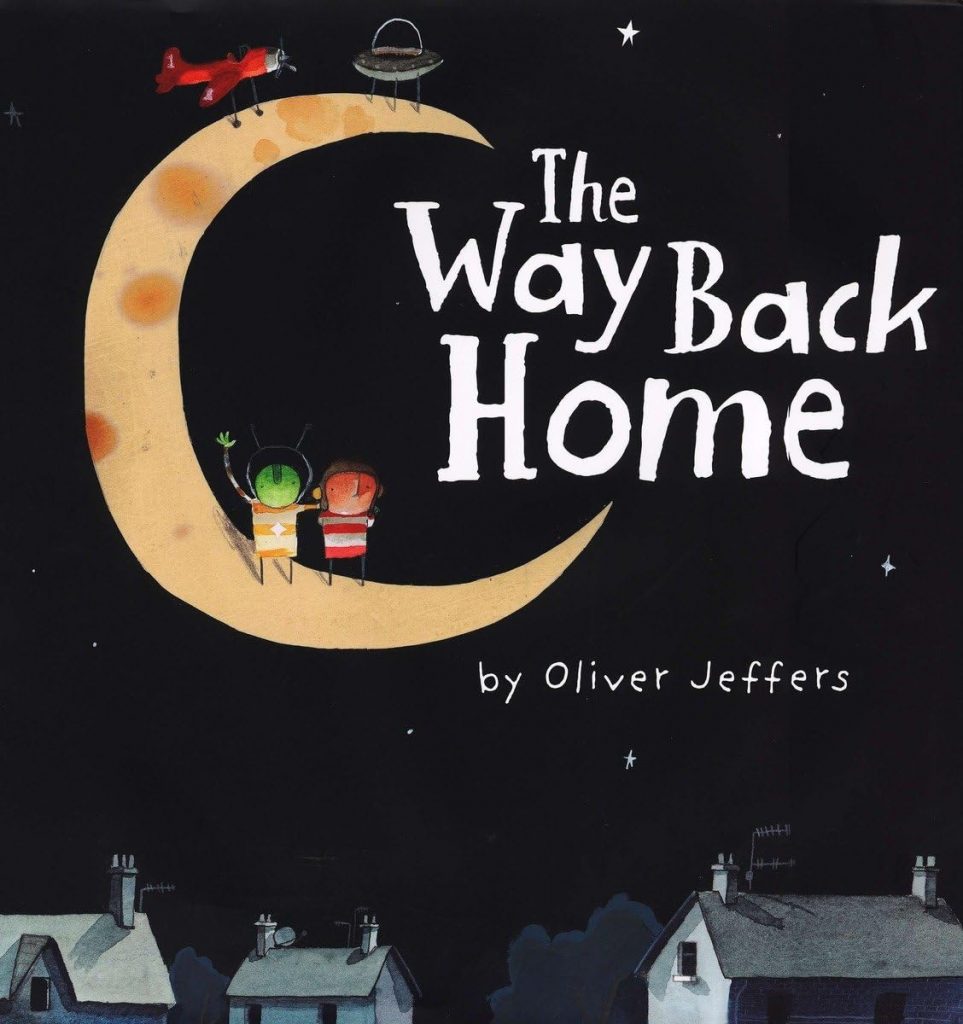
This picture book tells the story of a young boy who finds an airplane in his closet and decides to take it for a flight. The boy flies so high that he ends up in space, where he eventually lands on the moon after running out of fuel. There, he meets a Martian who has also become stranded. Together, they figure out a way to fix their aircrafts and each return to their respective homes.
The book explores the theme of space through the boy’s unexpected journey to the moon and his encounter with an alien, introducing children to the idea of space travel and extraterrestrial beings in a fun and imaginative way. Jeffers’ distinctive illustration style, characterized by expressive characters and minimalist landscapes, adds charm and depth to the simple storyline.
“The Way Back Home” is excellent reading material for young children because it combines adventure with themes of friendship and ingenuity. The story encourages problem-solving and cooperation as the boy and the Martian work together to overcome their predicament. It also touches on themes of loneliness and the joy of finding a friend in the most unlikely places.
Leave a Reply